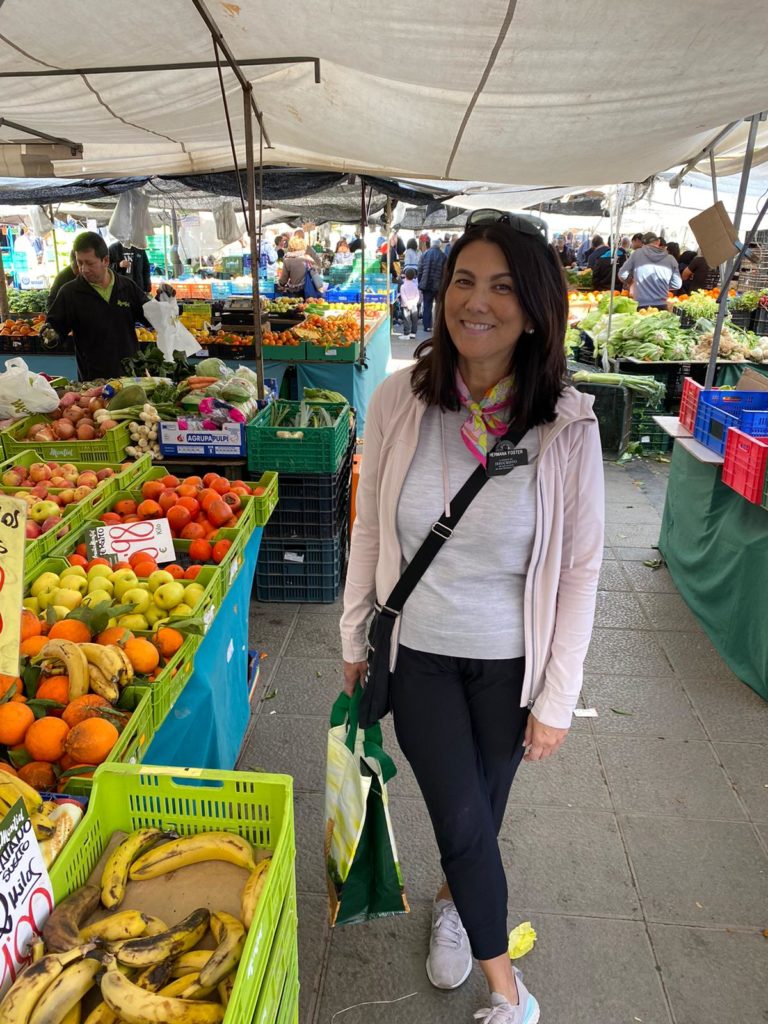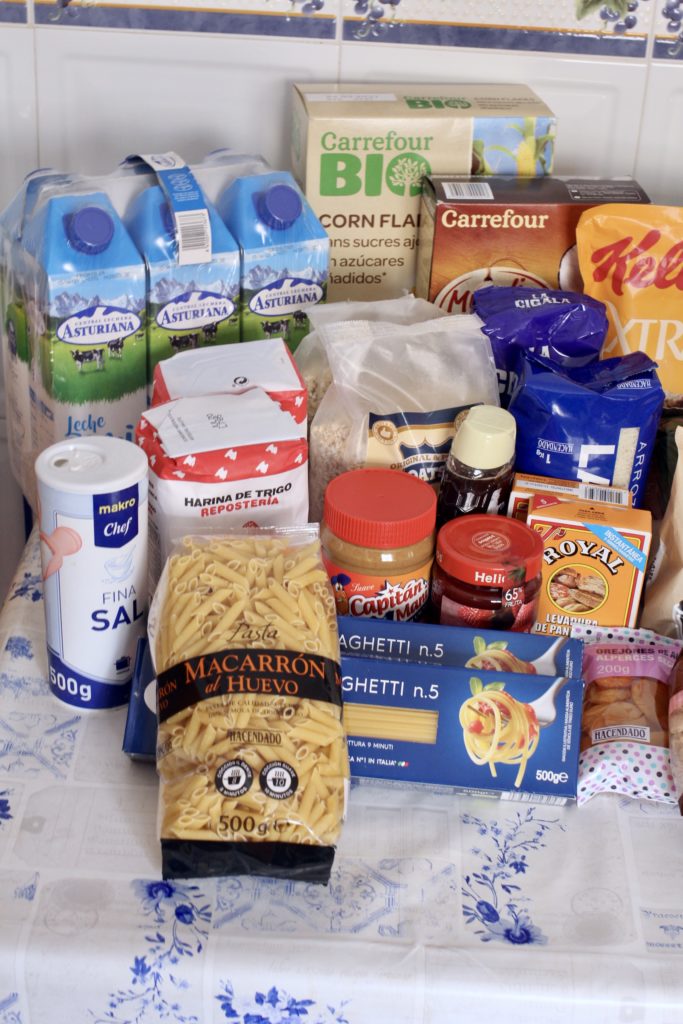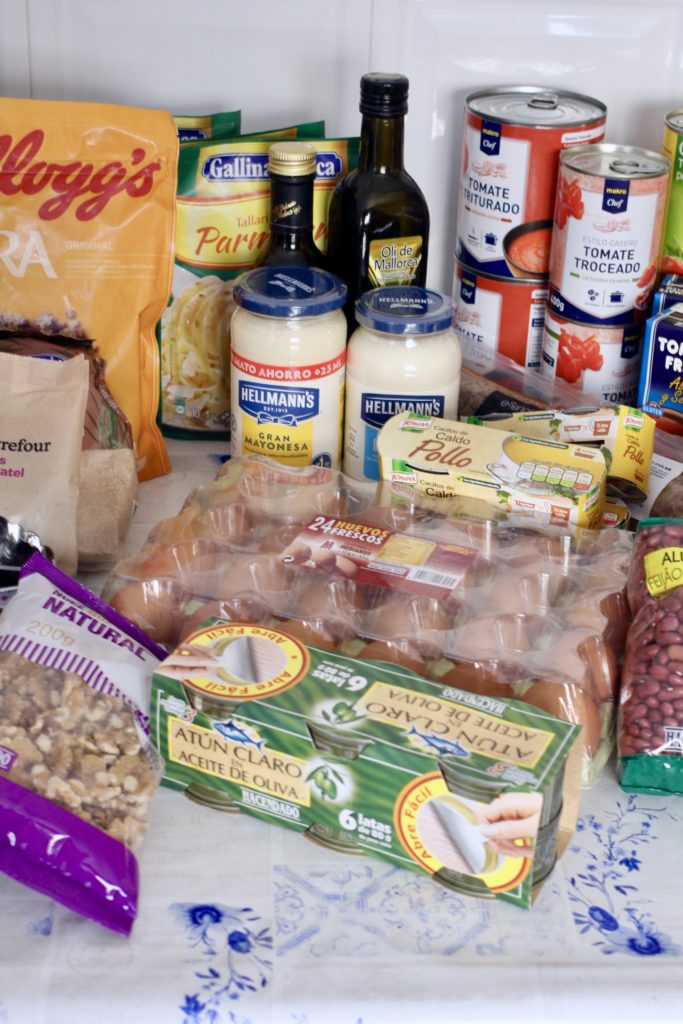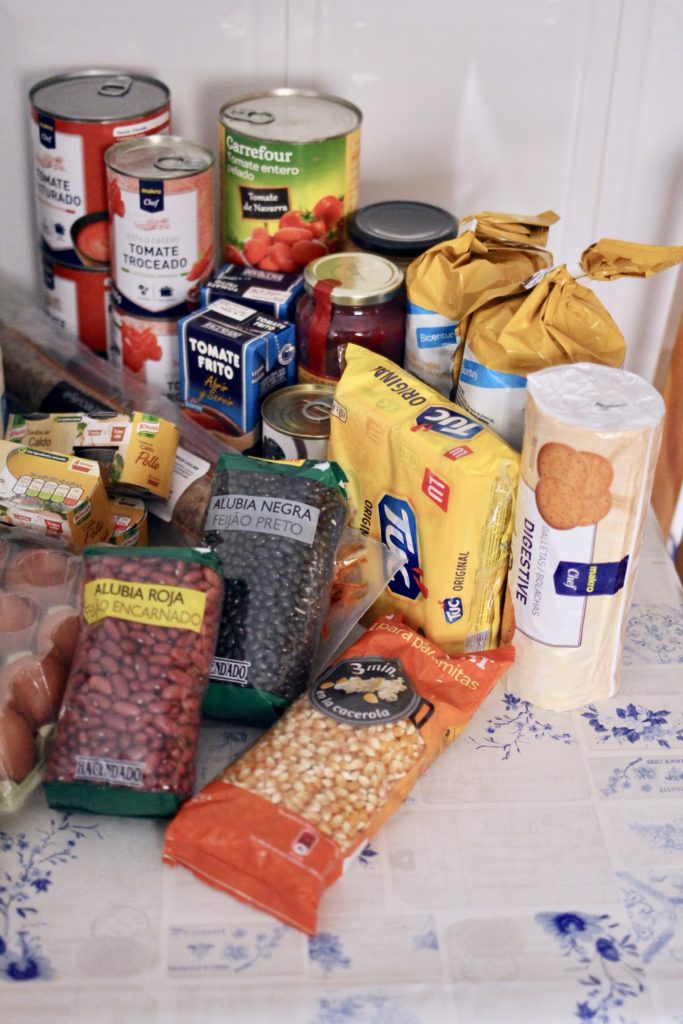Building a two week emergency food supply is easy. We did it in a couple of trips to a grocery store and you can too, without spending a lot of money.

Life in Mallorca, Spain
We are currently living in Spain, serving a mission for The Church of Jesus Christ of Latter Day Saints. Soon after we arrived in January of 2020, the Coronavirus or COVID-19 outbreak made headlines and started affecting us, even on the small island of Mallorca, Spain. By the time we had been here for a couple of weeks, reports of the virus on our little island started to circulate, and we didn’t pay much attention, thinking surely it wouldn’t affect us. China was a world away, and wouldn’t this turn out to be like all of the other illnesses that effected everyone but us?

Little did we know, a few weeks later, the world would change. Grant and I are (barely) 60 and 57, respectively. We decided to serve a mission for many reasons. We had not planned to serve for another 10 years, and then a series of events and prayers landed us here in Spain serving for 18 months. You can listen to our whole story here!
Early in February, we read about a patient in the hospital in Palma, Mallorca, who was being treated for the virus, who was later released. News about outbreaks in China seemed to be diverting everyones attention from the virus spreading to the US and Europe and still no one seemed to take the virus seriously. We certainly didn’t.

Creating a 72 hour, then a 2 week supply
I started to see a change at the grocery store in late February. Shelves that always seemed to be stocked full, were now emptying out. Popular items in Spain: rice, beans, olive oil and tuna were low, and it seemed like every time we went to the store there were more people and less products. I started to shop for a small emergency backup of 72 hours, as has been advised by our church leaders for decades.
News of people being quarantined around the world started to become more frequent, and we wanted to be prepared if this happened to us. Living on an island is a little different than living in Utah, where one could conceivably get in the car and drive as far as several states away (if needed) to buy food supplies.

After we built a 72 hour supply, we worked on a 2 week supply. The first thing I did when working on a two week supply was turn to the recommended food storage from the Church of Jesus Christ of Latter Day Saints, in the area of Self Reliance. I combined information found there, along with other sources to recommended items on the list. I worked with Ann Tyler, another senior missionary in the Spain, Barcelona mission, and Lark Galli (companion to our mission president) to compile this list for our missionaries in case of a quarantine or other situation where the missionaries are required to stay inside for several days.

Will I really need that much food?
It may seem like a lot of food for one person, but consider if you are contained at home for two weeks. What does that look like? I know myself, and when I’m at home for extended periods of time, I tend to eat more than when I am out and about and on my regular routine whether at home, or on the mission. All of the following factors come into play when building a two week emergency supply of food: Budget, (world) location, storage space, nutrition, allergies, food likes/dislikes and also what you may already have on hand including sweeteners, spices and condiments.

Simple tips for making the most of your two week food storage
Use food in refrigerator first. First, remember that most of us have food on hand in pantry and refrigerator and freezer. The food on this list will be used along with the food you regularly purchase. It is important to use the food that will spoil as soon as possible in an emergency situation. Think about the meals you will make using what is fresh first, then frozen food, and lastly, the shelf stable items.

It is fine to combine the three, but always use items with the shortest “shelf life” first. Example, looking in my fridge right now, I have several items on hand that will spoil if I wait for the end of a 2-3 week period to use. Those items are milk, yogurt, lunchmeat, lettuce. I will incorporate those items first to avoid throwing away food I can use. Don’t judge me for the amount of BUTTER I have on hand!

Use fresh items first
Yogurt and granola for breakfast instead of oatmeal are good options early on, if asked to avoid non-essential travel outside of our home. The oatmeal will last for a long time, because it is a shelf stable food requiring no refrigeration and also has a long term expiration date. I will also want to use the salad within the first few days. The carrots and red peppers are usually fresh for at least two weeks, so I will wait to use those later when we want to incorporate fresh veggies into something like this tasty stir fry, soup or stew.

Create storage you will eat, that is also nutritious
Choose foods that are nutritious and food you and your family will eat. It makes no sense to store food you will not use. It simply goes to waste. Trust me I have had years of experience storing food that went straight into the garbage instead of our stomachs! That said, storing 12 boxes of Captain Crunch is also not a good idea. The list at the bottom of this post will give you an idea of foods that are nutritious and will sustain you in an emergency situation. Remember, we are talking about a couple of weeks, not a lifetime storage. Make sure you are storing a BALANCED diet as your budget, space, and nutrition needs allow.
How to store flour, and how long will flour last?
I used to wonder if I should store wheat? It never crossed my mind that a way to grind the wheat was essential. If you don’t have a way to grind wheat, purchase an inexpensive wheat grinder or simply store flour instead. Flour can be stored on a pantry shelf along with yeast (so you can make bread), or in the freezer for months. All Purpose flour can be stored for up to one year after the expiration date, and up to two years if stored in an air tight container in the freezer.
Wheat flour tends to expire in a shorter period of time. Make sure to notice the date of expiration and mark the container if removing the flour from the original packaging. Flour tends to go rancid which is often detected by an odor or even a color change. Always store flour in a cool, dry place that is free from drastic temperature fluctuations. The garage is never a good place to store flour! One last note about yeast- I have had numerous readers tell me they have stored yeast in the freezer for up to 7 years with success. I store my yeast in a glass Mason jar.

Make sure to include a few treats
Treats come in many forms. Don’t over-do it here. If you have children, take them to the store and let them pick 1-2 shelf stable items to put in the 2 week supply. At the end of 6 months, let them eat the item and purchase a new one as you rotate your two week food supply. Chocolate chips can also work as a treat, and part of storage because it fills the treat category, but can also be used in making chocolate chip cookies for the family!

How much will a two week food supply cost?
How much will a two week supply cost? The two week supply in the photos in this post were purchased in Spain. We purchased the items here for about 120 Euros and the supply is adequate for one person. The guidelines, as I said before, for the items and quantities were gathered from several sources. The amount you spend will vary depending on the items purchased. Meat costs more than crackers, but you don’t want to survive on crackers unless there are no other options!

How much water do I need for a two week supply?
Water is an essential item to include when building a two week emergency supply of food. The recommended amount of water from all sources to store is 1 gallon of water per person, per day. This covers water for drinking and preparing foods such as oatmeal, soup, etc and for brushing teeth if needed. In the case of say, a pandemic, and not a situation where the water supply might be contaminated or unavailable (such as in a natural disaster), there is no need to run out and buy cases of water. The water from the tap is safe to use. Think and use rational, calm decision making when making purchases. Water storage is always a good idea, but not in excess. The water in Spain is safe to drink and therefore non essential for a possible quarantine, which is our area of focus.
Shop for items easy to find in your environment
This is the list (below) we sent out when the missionaries were instructed to purchase a two week supply. I’ve altered it a bit to show the items you might purchase in the U.S., such as canned chicken, which is not found in Spain. Alternatively, Chorizo or Jamon (cured, dry meats) are found everywhere in Spain!
This list only includes food items. Items such as detergent, soap, sanitizer, hygiene supplies etc are not included. Also, if you have a baby and use formula and diapers, or have pets needing food, those items should be added.

How to build a two week food supply…a little at a time, or all one trip
If you have the time and luxury of not buying immediately, build your supply the easy way by purchasing a few items on the list each time you go to the store or get online using mail, delivery or pick up services. Many of the items are found on Amazon and other emergency food supply sources. We purchased dry pack food storage from our local facility from the Church of Jesus Christ in Kaysville, Utah years ago.
This storage has lasted for years and has a 30+year shelf life. I use many of the dry pack foods such as oats, pasta, hot cocoa, dry milk in every day cooking and continue to rotate in my regular menus. They are all very good quality and has been one of the best investments we have made. You may purchase similar dry pack items online.
A Bountiful Kitchen is filled with over 700 recipes, many which will be useful as you make meals using your food storage items! When building your two week food supply, think about recipes your family loves. Do they love mac and cheese or chicken casseroles?

Look at the needed groceries and purchase those items, especially the shelf stable items that you need to make recipes you love. We love this Southwest Soup. It is easy to make. And most of the ingredients are shelf stable and perfect for a two week supply. ABK’s Minestrone Soup is meatless and filled with beans which are an excellent source of fiber and protein and again many ingredients are perfect storage items.

Recipes you may find helpful when planning and cooking with a two week food supply:
Biscuits and Sausage Gravy I like to serve this with over easy eggs
Instant Pot Steel Cut Oats The Instant Pot is a great tool to use when preparing food from your 2 week supply

Peanut Butter and Cashew Granola
The Best Instant Pot Mac and Cheese not only a kid favorite, adults love it too!
Twenty Minute White Chicken Chili


I would love to hear any comments or suggestions you have for building a two week (or any amount) of food storage supply, and ideas for what you make with your food storage. Stay safe my friends!
Two Week Food Supply for One Person
Ingredients
Flour/Grain 10-15 lbs total combined:
- Flour for baked goods, gravies, thickening in soups
- White rice Brown rice does not store well for long periods of time, white rice is best for storage
- Oatmeal Quick or Old fashioned for breakfast or to make granola, cookies
- Corn canned
- Pasta for soups, casserole
- Cereal/granola – three boxes breakfast
Beans/Legumes/Protein, 2 lbs total:
- Beans dry/jars or canned for soups, salds, main dish
- Lentils dry/jars or canned For soups, salads, main dish
- Chorizo or other dried sausage sold outside of refrigeration chop and add to soups, salads, snack
- Nuts snack, add to granola
Dairy and fats
- 5-7 boxes Milk cow or otherwise, non-refrigerated boxes- check expiration date for longest lasting
- Oil – 1 lb suggest olive oil for cooking, salads
Canned Items:
- Canned tuna, chicken or salmon 7 cans combined
- Canned soup and/or Chili 7 cans
- Canned olives 3 cans
- Canned tomatoes, tomato sauce and paste 2 cans each to make sauce
Spices, condiments, sweeteners, misc
- Peanut/almond butter- one jar
- Bouillon/broth chicken beef and or vegetable to make soup, gravy or for hot drink/snack
- Dried onion flakes/dried garlic for seasoning
- Mayonnaise, one jar
- Dry yeast
- Maple syrup for pancakes, granola
- Honey, Sugar, Brown sugar, Jam
Pre made Mixes/meals
- Pasta sauce- 4 jars
- Packaged soup mix / packaged pasta mix / Mac n cheese / ramen
- Pancake mix
Snacks
- Crackers- 2 boxes
- Vegetable juice for snack, in soups
- Raisins/dried fruit breakfast or snack
- Snacks: popcorn, granola bars, chocolate bar
Other Items not Shelf Stable but helpful to create meals
- Fresh fruit or frozen
- Fresh vegetables or frozen
- Bread may be frozen
- cheese, vacuum packaged
- butter, 1 lb frozen
- Eggs 1-2 dozen Not fully shelf-stable, but if purchased not refrigerated are stable outside of the refrigerator for one week. Most eggs sold in the US are safe to eat if kept refrigerated up to the expiration date on carton. See notes below for link to FDA guidelines.
Water
- Water- 1 gallon per person per day
Notes
- Remember to use items you have on hand to supplement your supply. Use fresh items first or at the beginning of time spent at home.
- If possible, have your children help create meal plans and prepare, they will be more invested and more willing to eat if they are involved.
- You may freeze leftover soup, treats, bread, and many other items and use the second week to avoid waste.
- Everything you need to know about egg safety, avoiding salmonella, etc you can find here.
Did you make this recipe?
Be sure to leave a comment and give this recipe a rating, letting me know how you liked it. I’d love to see a photo, tag @abountifulkitchen on Instagram!

Stephanie Giorgi
This post and shopping/storage list is very helpful and packed with carefully thought out information! I also appreciate how calmly you present the information and how you remind us all that preparation for events, big and small; planned or natural disaster quarantines, should be something we incorporate into our everyday lives. Thank you for still supporting your online community even while you serve your Mission. Bless you!
Si Foster
Thank you Stephanie! Im glad this is helpful to you 🙂 Thanks for reading ABK!
xo
Si
Vicki
Excuse me, I should have thanked you for the great post on the two week supply before I commented on the egg storage concern. Your list will be so helpful for our missionaries and others.
Si Foster
Thank you Vicki! Im glad this is helpful to you and I will make a change to note about the egg storage concern!
xo
Si
Sandi
These are fantastic tips! Having been through two hurricanes, I’d encourage people to think about cooking methods that don’t use electricity as well. One thing we found helpful is using a gas grill as a makeshift oven. Not applicable in every situation, but something to consider if storms or earthquakes may cut power.
Si Foster
You have a wealth of knowledge if you have survived two hurricanes Sandi! Thank you for your insight on cooking methods. Many of us have grills and forget to use that method as a backup. Thanks for reading ABK,
xo
Si
Vicki
As some missionary mothers stateside are recommending your list to missionaries please note that eggs purchased in the US are not vaccinated for salmonella and therefore should not be unrefrigerated. You mentioned it briefly but it could be misunderstood I think.
Si Foster
Will do, thank you!
LJ
Thanks for this!! These are great tips.
Si Foster
LJ,
Thank you for reading ABK!
xo
Si